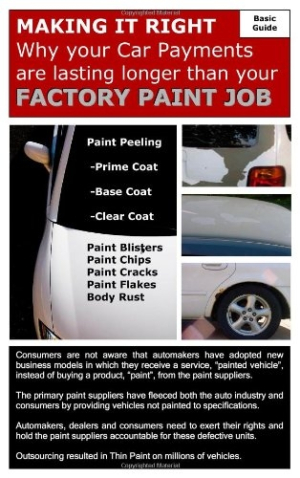Making It Right
Why your Car Payments are Lasting Longer than your Factory Paint Job, Technical Guide, Basic Guide
Imagining the auto paint business as a pizza chain that guarantees one hundred mini-slices of pepperoni per pizza but provides diners with as few as sixty-five, these two volumes—Technical Guide for auto industry professionals and a Basic Guide for laypeople—warn of routine deceptions in the automotive paint industry that netted an estimated “$8.97 billion in 2007.” Stephen Gaiski, the technical director for Zestar, a Michigan-based company specializing in the “intellectual property licensing of automotive paint applications software,” methodically documents how DuPont, BASF, and PPG, the three main players in the global auto paint industry, routinely sell thin, inferior paint without alerting anyone in the supply chain to the deficiency. Those who rely on the quality of their work—auto manufacturers, dealers, body shops, and individual consumers—are as unlikely to count the pepperoni slices on their pizza as they are to attribute defective paint jobs to deliberate deception.
Despite disclaimers that Zestar’s information may not be fully accurate and that it is not intended as legal advice, Gaiski, winner of the Automotive World Wide Quality Award, details a project that aligns itself with the goals of consumer protection agencies such as Ralph Nader’s Public Interest Research Group. Although defective automotive paint is neither as deadly as Union Carbide’s toxic gas explosion in Bhopal, India nor as environmentally destructive as BP’s Gulf Coast oil spill, any industry-wide fleecing of buyers on every continent certainly deserves recognition.
Painting a car is a four-step process that requires a car to be “baked” three times: after the “electrocoat,” after the “primer,” and then after “2 wet” applications of the “base coat” and “clear coat.” Together, they serve multiple purposes: preventing corrosion, smoothing the surface, improving adhesion between coats, providing color, protecting against sunlight and acid rain, and giving the car the glossy finish that consumers prize.Different “film builds” or “thicknesses” are necessary for each level if a paint job is to be successful; industry standards are that a car’s paint job should last for fifteen years—the longest lifespan of most vehicles.
Likening the fraud he alleges to “gravy,” Gaiski writes, “Each dollar saved per unit by the paint supplier is that much more profit for both the paint supplier and the automaker.” Such cost-cutting measures result in premature “paint delamination” on millions of cars. When paint “loses adhesion,” it bubbles, cracks, blisters, and peels, causing premature rust and corrosion, thereby lowering the car’s value because of lost cosmetic appeal. Gaiski estimates that “for every reported complaint,” at least six car owners do not report the paint problems on their cars.
Car owners under-report defective paint jobs because they do not know that the paint jobs are supposed to last. Instead, they assume that the manufacturer of their car isat fault and decide never to buy its products again. Zestar has found many online complaints directed at two of America’s most troubled automakers, Ford and Chrysler. One wonders how many former Ford and Chrysler employees lost their jobs because of their employers’ lost prestige and sales.
Noting that “the reality in business is that if you ignore ethics, it will eventually catch up to you,” Gaiski documents shockingly high defect rates. The 2000-2003 Ford Taurus had a 96.5% defect rate in cars painted with DuPont’s products, and Chrysler was similarly cheated by PPG, despite contract specifications that PPG would not be paid “until each vehicle passed inspection.” In many cases, defective paint is specifically excluded from warranty coverage by clauses that blame defects on automakers instead of on the paint companies.
The Basic Guide for consumers reiterates much of the information supplied in the guide for industry professionals without the technical details that could be off-putting for laypeople. Its straightforward language and easy-to-read presentation of statistics provides ample and persuasive evidence that the issue of defective car paint is one that directly affects car owners. For example, in Ford’s Kansas City facility for the production of the Ford Escape and Mazda Tribute, Gaiski writes that there was a “0.20%” compliance rate for the primer coat. He goes on: “No, that is not an error. 99.80% of all vehicles produced lacked sufficient primer 3 consecutive years.” Numbers in large bold print jump off the page to engage readers with information they might not initially view as compelling.
Zestar developed the Basic Guide in response to the comments of “family and friends” of its employees who suggested a shortened, less technical version for general readers. No important information has been left out, and each chapter is included in a shortened, more colorful form with comments such as “peeling like a banana” and “paint doesn’t last as long as payments.” Car owners will want to know about companies lurking in the shadows behind the brand names that they trusted enough to spend their money on. This shortened, accessible volume provides a persuasive study that will remind readers that the evidence of corporate dishonesty and deception peels off like the layers of an onion—or the paint on that car they just bought. (June 2010)
Reviewed by
Elizabeth Breau
Disclosure: This article is not an endorsement, but a review. The publisher of this book provided free copies of the book and paid a small fee to have their book reviewed by a professional reviewer. Foreword Reviews and Clarion Reviews make no guarantee that the publisher will receive a positive review. Foreword Magazine, Inc. is disclosing this in accordance with the Federal Trade Commission’s 16 CFR, Part 255.

